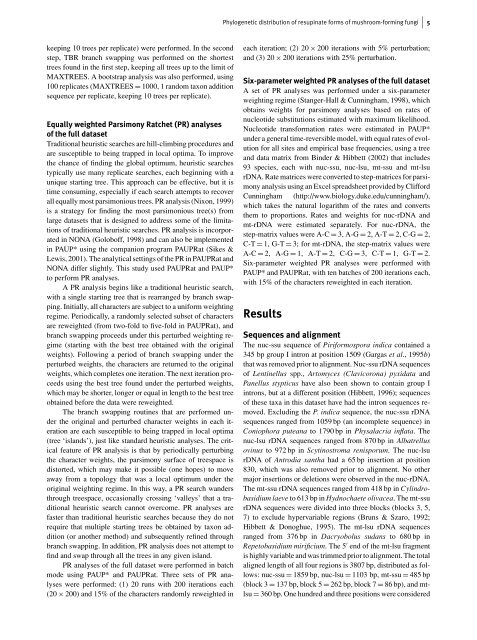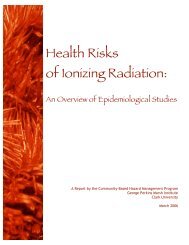The phylogenetic distribution of resupinate forms ... - Clark University
The phylogenetic distribution of resupinate forms ... - Clark University
The phylogenetic distribution of resupinate forms ... - Clark University
Create successful ePaper yourself
Turn your PDF publications into a flip-book with our unique Google optimized e-Paper software.
keeping 10 trees per replicate) were performed. In the second<br />
step, TBR branch swapping was performed on the shortest<br />
trees found in the first step, keeping all trees up to the limit <strong>of</strong><br />
MAXTREES. A bootstrap analysis was also performed, using<br />
100 replicates (MAXTREES = 1000, 1 random taxon addition<br />
sequence per replicate, keeping 10 trees per replicate).<br />
Equally weighted Parsimony Ratchet (PR) analyses<br />
<strong>of</strong> the full dataset<br />
Traditional heuristic searches are hill-climbing procedures and<br />
are susceptible to being trapped in local optima. To improve<br />
the chance <strong>of</strong> finding the global optimum, heuristic searches<br />
typically use many replicate searches, each beginning with a<br />
unique starting tree. This approach can be effective, but it is<br />
time consuming, especially if each search attempts to recover<br />
all equally most parsimonious trees. PR analysis (Nixon, 1999)<br />
is a strategy for finding the most parsimonious tree(s) from<br />
large datasets that is designed to address some <strong>of</strong> the limitations<br />
<strong>of</strong> traditional heuristic searches. PR analysis is incorporated<br />
in NONA (Golob<strong>of</strong>f, 1998) and can also be implemented<br />
in PAUP* using the companion program PAUPRat (Sikes &<br />
Lewis, 2001). <strong>The</strong> analytical settings <strong>of</strong> the PR in PAUPRat and<br />
NONA differ slightly. This study used PAUPRat and PAUP*<br />
to perform PR analyses.<br />
A PR analysis begins like a traditional heuristic search,<br />
with a single starting tree that is rearranged by branch swapping.<br />
Initially, all characters are subject to a uniform weighting<br />
regime. Periodically, a randomly selected subset <strong>of</strong> characters<br />
are reweighted (from two-fold to five-fold in PAUPRat), and<br />
branch swapping proceeds under this perturbed weighting regime<br />
(starting with the best tree obtained with the original<br />
weights). Following a period <strong>of</strong> branch swapping under the<br />
perturbed weights, the characters are returned to the original<br />
weights, which completes one iteration. <strong>The</strong> next iteration proceeds<br />
using the best tree found under the perturbed weights,<br />
which may be shorter, longer or equal in length to the best tree<br />
obtained before the data were reweighted.<br />
<strong>The</strong> branch swapping routines that are performed under<br />
the original and perturbed character weights in each iteration<br />
are each susceptible to being trapped in local optima<br />
(tree ‘islands’), just like standard heuristic analyses. <strong>The</strong> critical<br />
feature <strong>of</strong> PR analysis is that by periodically perturbing<br />
the character weights, the parsimony surface <strong>of</strong> treespace is<br />
distorted, which may make it possible (one hopes) to move<br />
away from a topology that was a local optimum under the<br />
original weighting regime. In this way, a PR search wanders<br />
through treespace, occasionally crossing ‘valleys’ that a traditional<br />
heuristic search cannot overcome. PR analyses are<br />
faster than traditional heuristic searches because they do not<br />
require that multiple starting trees be obtained by taxon addition<br />
(or another method) and subsequently refined through<br />
branch swapping. In addition, PR analysis does not attempt to<br />
find and swap through all the trees in any given island.<br />
PR analyses <strong>of</strong> the full dataset were performed in batch<br />
mode using PAUP* and PAUPRat. Three sets <strong>of</strong> PR analyses<br />
were performed: (1) 20 runs with 200 iterations each<br />
(20 × 200) and 15% <strong>of</strong> the characters randomly reweighted in<br />
Phylogenetic <strong>distribution</strong> <strong>of</strong> <strong>resupinate</strong> <strong>forms</strong> <strong>of</strong> mushroom-forming fungi 5<br />
each iteration; (2) 20 × 200 iterations with 5% perturbation;<br />
and (3) 20 × 200 iterations with 25% perturbation.<br />
Six-parameter weighted PR analyses <strong>of</strong> the full dataset<br />
A set <strong>of</strong> PR analyses was performed under a six-parameter<br />
weighting regime (Stanger-Hall & Cunningham, 1998), which<br />
obtains weights for parsimony analyses based on rates <strong>of</strong><br />
nucleotide substitutions estimated with maximum likelihood.<br />
Nucleotide transformation rates were estimated in PAUP*<br />
under a general time-reversible model, with equal rates <strong>of</strong> evolution<br />
for all sites and empirical base frequencies, using a tree<br />
and data matrix from Binder & Hibbett (2002) that includes<br />
93 species, each with nuc-ssu, nuc-lsu, mt-ssu and mt-lsu<br />
rDNA. Rate matrices were converted to step-matrices for parsimony<br />
analysis using an Excel spreadsheet provided by Clifford<br />
Cunningham (http://www.biology.duke.edu/cunningham/),<br />
which takes the natural logarithm <strong>of</strong> the rates and converts<br />
them to proportions. Rates and weights for nuc-rDNA and<br />
mt-rDNA were estimated separately. For nuc-rDNA, the<br />
step-matrix values were A-C = 3, A-G = 2, A-T = 2, C-G = 2,<br />
C-T = 1, G-T = 3; for mt-rDNA, the step-matrix values were<br />
A-C = 2, A-G = 1, A-T = 2, C-G = 3, C-T = 1, G-T = 2.<br />
Six-parameter weighted PR analyses were performed with<br />
PAUP* and PAUPRat, with ten batches <strong>of</strong> 200 iterations each,<br />
with 15% <strong>of</strong> the characters reweighted in each iteration.<br />
Results<br />
Sequences and alignment<br />
<strong>The</strong> nuc-ssu sequence <strong>of</strong> Piriformospora indica contained a<br />
345 bp group I intron at position 1509 (Gargas et al., 1995b)<br />
that was removed prior to alignment. Nuc-ssu rDNA sequences<br />
<strong>of</strong> Lentinellus spp., Artomyces (Clavicorona) pyxidata and<br />
Panellus stypticus have also been shown to contain group I<br />
introns, but at a different position (Hibbett, 1996); sequences<br />
<strong>of</strong> these taxa in this dataset have had the intron sequences removed.<br />
Excluding the P. indica sequence, the nuc-ssu rDNA<br />
sequences ranged from 1059 bp (an incomplete sequence) in<br />
Coniophora puteana to 1790 bp in Physalacria inflata. <strong>The</strong><br />
nuc-lsu rDNA sequences ranged from 870 bp in Albatrellus<br />
ovinus to 972 bp in Scytinostroma renisporum. <strong>The</strong> nuc-lsu<br />
rDNA <strong>of</strong> Antrodia xantha had a 65 bp insertion at position<br />
830, which was also removed prior to alignment. No other<br />
major insertions or deletions were observed in the nuc-rDNA.<br />
<strong>The</strong> mt-ssu rDNA sequences ranged from 418 bp in Cylindrobasidium<br />
laeve to 613 bp in Hydnochaete olivacea. <strong>The</strong> mt-ssu<br />
rDNA sequences were divided into three blocks (blocks 3, 5,<br />
7) to exclude hypervariable regions (Bruns & Szaro, 1992;<br />
Hibbett & Donoghue, 1995). <strong>The</strong> mt-lsu rDNA sequences<br />
ranged from 376 bp in Dacryobolus sudans to 680 bp in<br />
Repetobasidium mirificium.<strong>The</strong>5 ′ end <strong>of</strong> the mt-lsu fragment<br />
is highly variable and was trimmed prior to alignment. <strong>The</strong> total<br />
aligned length <strong>of</strong> all four regions is 3807 bp, distributed as follows:<br />
nuc-ssu = 1859 bp, nuc-lsu = 1103 bp, mt-ssu = 485 bp<br />
(block 3 = 137 bp, block 5 = 262 bp, block 7 = 86 bp), and mtlsu<br />
= 360 bp. One hundred and three positions were considered
















